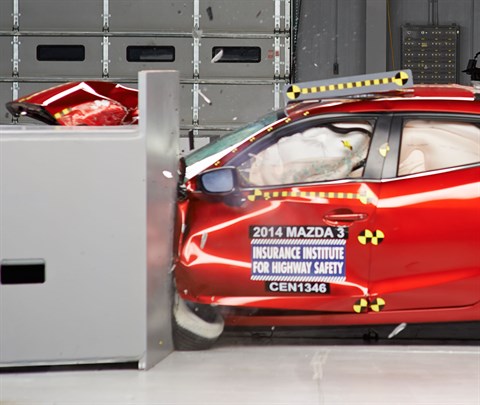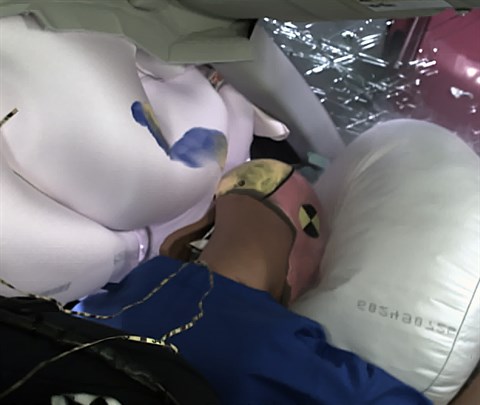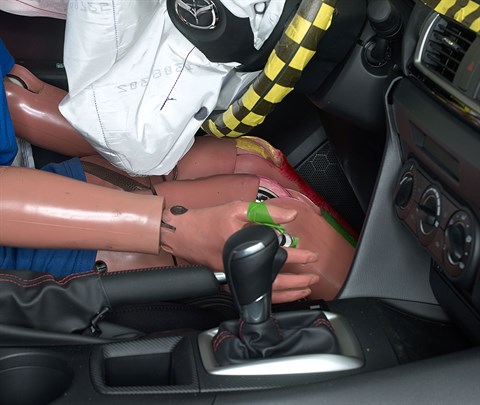Small overlap front: driver-side
Tested vehicle: 2014 Mazda 3 i-Touring 4-door
Rating applies to 2014-18 models built after October 2013
The Mazda 3 was redesigned for the 2014 model year. Beginning with 2014 models built after October 2013, the front suspension was modified to improve occupant protection in small overlap frontal crashes. (Information about when a specific vehicle was manufactured is on the certification label typically affixed to the car on the driver door or adjacent B-pillar.) The small overlap frontal ratings apply to both the hatchback and sedan versions of the Mazda 3.
| Evaluation criteria | Rating |
|---|---|
| Overall evaluation | |
| Structure and safety cage | |
| Driver injury measures | |
| Head/neck | |
| Chest | |
| Hip/thigh | |
| Lower leg/foot | |
| Driver restraints and dummy kinematics | |

Action shot taken during the small overlap frontal crash test.

The dummy's position in relation to the door frame, steering wheel, and instrument panel after the crash test indicates that the driver's survival space was maintained well.

The frontal and side curtain airbags worked well together to keep the head from coming close to any stiff structure or outside objects that could cause injury.

Forces on the right lower leg were just high enough to indicate a moderate risk of injury.
Measures of occupant compartment intrusion on driver side
| Evaluation criteria | Measurement |
|---|---|
| Test ID | CEN1346 |
| Lower occupant compartment | |
| Lower hinge pillar max (cm) | 12 |
| Footrest (cm) | 8 |
| Left toepan (cm) | 3 |
| Brake pedal (cm) | 5 |
| Parking brake (cm) | |
| Rocker panel lateral average (cm) | 1 |
| Upper occupant compartment | |
| Steering column | 0 |
| Upper hinge pillar max (cm) | 4 |
| Upper dash (cm) | 7 |
| Lower instrument panel (cm) | 9 |
Driver injury measures
| Evaluation criteria | Measurement |
|---|---|
| Test ID | CEN1346 |
| Head | |
| HIC-15 | 210 |
| Peak gs at hard contact | no contact |
| Neck | |
| Tension (kN) | 1.5 |
| Extension bending moment (Nm) | 5 |
| Maximum Nij | 0.25 |
| Chest maximum compression (mm) | 24 |
| Femur (kN) | |
| Left | 0.5 |
| Right | 0.2 |
| Knee displacement (mm) | |
| Left | 1 |
| Right | 1 |
| Knee-thigh-hip injury risk (%) | |
| Left | 0 |
| Right | 0 |
| Maximum tibia index | |
| Left | 0.46 |
| Right | 0.86 |
| Tibia axial force (kN) | |
| Left | 1.2 |
| Right | 1.5 |
| Foot acceleration (g) | |
| Left | 50 |
| Right | 54 |
Moderate overlap front: original test
Tested vehicle: 2014 Mazda 3 i-Touring 4-door
Rating applies to 2014-18 models
The Mazda 3 was redesigned for the 2014 model year. Moderate overlap frontal ratings are assigned by the Institute based on a test conducted by Mazda. These ratings apply to both the sedan and hatchback versions of the Mazda 3.
| Evaluation criteria | Rating |
|---|---|
| Overall evaluation | |
| Structure and safety cage | |
| Driver injury measures | |
| Head/neck | |
| Chest | |
| Leg/foot, left | |
| Leg/foot, right | |
| Driver restraints and dummy kinematics | |
Measures of occupant compartment intrusion on driver side
| Evaluation criteria | Measurement |
|---|---|
| Test ID | VTF1315 |
| Footwell intrusion | |
| Footrest (cm) | 3 |
| Left (cm) | 7 |
| Center (cm) | 8 |
| Right (cm) | 2 |
| Brake pedal (cm) | 2 |
| Instrument panel rearward movement | |
| Left (cm) | 0 |
| Right (cm) | -1 |
| Steering column movement | |
| Upward (cm) | -4 |
| Rearward (cm) | -5 |
| A-pillar rearward movement (cm) | 0 |
Driver injury measures
| Evaluation criteria | Measurement |
|---|---|
| Test ID | VTF1315 |
| Head | |
| HIC-15 | 124 |
| Peak gs at hard contact | no contact |
| Neck | |
| Tension (kN) | 1.2 |
| Extension bending moment (Nm) | 14 |
| Maximum Nij | 0.24 |
| Chest maximum compression (mm) | 35 |
| Legs | |
| Femur force - left (kN) | 0.5 |
| Femur force - right (kN) | 0.3 |
| Knee displacement - left (mm) | 0 |
| Knee displacement - right (mm) | 0 |
| Maximum tibia index - left | 0.41 |
| Maximum tibia index - right | 0.53 |
| Tibia axial force - left (kN) | 2.0 |
| Tibia axial force - right (kN) | 2.1 |
| Foot acceleration (g) | |
| Left | 44 |
| Right | 64 |
Side: original test
Tested vehicle: 2014 Mazda 3 i-Touring 4-door with standard front and rear head curtain airbags and standard front seat-mounted torso airbags
Rating applies to 2014-18 models
The Mazda 3 was redesigned for the 2014 model year. Side ratings are assigned by the Institute based on a test conducted by Mazda. These ratings apply to both the sedan and hatchback versions of the Mazda 3.
| Evaluation criteria | Rating |
|---|---|
| Overall evaluation | |
| Structure and safety cage | |
| Driver injury measures | |
| Head/neck | |
| Torso | |
| Pelvis/leg | |
| Driver head protection | |
| Rear passenger injury measures | |
| Head/neck | |
| Torso | |
| Pelvis/leg | |
| Rear passenger head protection | |
Measures of occupant compartment intrusion on driver side
| Test ID | VTS1310 |
|---|---|
| B-pillar to longitudinal centerline of driver's seat (cm) | -14.0 |
| Negative numbers indicate the amount by which the crush stopped short of the seat centerline. | |
Driver injury measures
| Evaluation criteria | Measurement |
|---|---|
| Test ID | VTS1310 |
| Head HIC-15 | 408 |
| Neck | |
| Tension (kN) | 0.9 |
| Compression (kN) | 0.4 |
| Shoulder | |
| Lateral deflection (mm) | 32 |
| Lateral force (kN) | 1.5 |
| Torso | |
| Maximum deflection (mm) | 32 |
| Average deflection (mm) | 29 |
| Maximum deflection rate (m/s) | 3.76 |
| Maximum viscous criterion (m/s) | 0.42 |
| Pelvis | |
| Iliac force (kN) | 1.5 |
| Acetabulum force (kN) | 1.3 |
| Combined force (kN) | 2.6 |
| Left femur | |
| L-M force (kN) | 1.9 |
| L-M moment (Nm) | 114 |
| A-P moment (Nm) | 138 |
Passenger injury measures
| Evaluation criteria | Measurement |
|---|---|
| Test ID | VTS1310 |
| Head HIC-15 | 113 |
| Neck | |
| Tension (kN) | 0.3 |
| Compression (kN) | 0.5 |
| Shoulder | |
| Lateral deflection (mm) | 48 |
| Lateral force (kN) | 1.8 |
| Torso | |
| Maximum deflection (mm) | 42 |
| Average deflection (mm) | 32 |
| Maximum deflection rate (m/s) | 2.61 |
| Maximum viscous criterion (m/s) | 0.58 |
| Pelvis | |
| Iliac force (kN) | 0.1 |
| Acetabulum force (kN) | 1.6 |
| Combined force (kN) | 1.6 |
| Left femur | |
| L-M force (kN) | 1.1 |
| L-M moment (Nm) | 49 |
| A-P moment (Nm) | 158 |
Roof strength
Tested vehicle: 2014 Mazda 3 i Touring 4-door
Rating applies to 2014-18 models
Rating applies to both the Mazda 3 hatchback (tested) and the structurally similar Mazda 3 sedan.
| Overall evaluation | |
|---|---|
| Curb weight | 2,866 lbs |
| Peak force | 18,217 lbs |
| Strength-to-weight ratio | 6.36 |
Head restraints & seats
Seat type: Manual cloth seat
| Overall evaluation | |
|---|---|
| Dynamic rating | |
| Seat/head restraint geometry |
| Seat type | Manual cloth seat |
|---|---|
| Geometry | |
| Backset (mm) | 14 |
| Distance below top of head (mm) | 4 |
| Seat design parameters | |
| Pass/fail | Pass |
| Max T1 acceleration (g) | 11.1 |
| Head contact time (ms) | 61 |
| Force rating | 1 |
| Neck forces | |
| Max neck shear force (N) | 0 |
| Max neck tension (N) | 396 |
About the head restraint & seat test
Currently, IIHS tests apply only to front seats.
